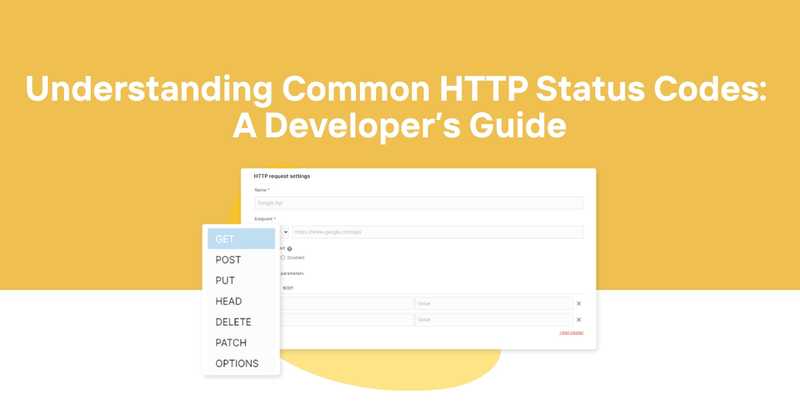Understanding Common HTTP Status Codes: A Developer's Guide
Introduction
HTTP status codes are the silent communicators of the web, conveying crucial information about the outcome of requests between clients and servers. As a developer, having a solid grasp of these codes is essential for building robust applications, troubleshooting issues, and optimizing user experiences. In this comprehensive guide, we'll dive deep into the world of HTTP status codes, exploring their significance, categories, and practical implications for modern web development.
Table of Contents
- The Basics of HTTP Communication
- HTTP Status Code Categories
- Informational Responses (1xx)
- Successful Responses (2xx)
- Redirection Messages (3xx)
- Client Error Responses (4xx)
- Server Error Responses (5xx)
- Impact on SEO and User Experience
- Best Practices for Handling Status Codes
- Tools for Monitoring and Debugging HTTP Status Codes
- Conclusion
The Basics of HTTP Communication
Before we delve into specific status codes, it's crucial to understand the foundation of HTTP communication. The Hypertext Transfer Protocol (HTTP) is the backbone of data exchange on the web, facilitating the transfer of information between clients (usually web browsers) and servers.
When a client sends a request to a server, the server processes that request and returns a response. This response always includes a three-digit status code, which provides immediate insight into the outcome of the request. These codes are grouped into five classes, each serving a distinct purpose in the communication process.
HTTP Status Code Categories
HTTP status codes are organized into five categories, each identifiable by the first digit of the code:
- 1xx (Informational): The request was received, and the process is continuing.
- 2xx (Successful): The request was successfully received, understood, and accepted.
- 3xx (Redirection): Further action needs to be taken to complete the request.
- 4xx (Client Error): The request contains bad syntax or cannot be fulfilled by the server.
- 5xx (Server Error): The server failed to fulfill a valid request.
Let's explore each category in detail, focusing on the most common and important status codes within each group.
Informational Responses (1xx)
Informational status codes are relatively rare in day-to-day web development. They indicate that the server has received the request headers and that the client should proceed to send the request body or wait for further instructions.
100 Continue
This interim response indicates that everything so far is OK and that the client should continue with the request or ignore it if it's already finished.
101 Switching Protocols
This code is sent in response to an Upgrade request header from the client and indicates the protocol the server is switching to.
103 Early Hints
Primarily used with the Link header, this status code allows the user agent to start preloading resources while the server prepares a response.
While these codes are less frequently encountered, understanding them can be valuable when working with complex, multi-step requests or when optimizing resource loading.
Successful Responses (2xx)
Successful status codes indicate that the client's request was received, understood, and accepted by the server. These are the responses you typically aim for in most web interactions.
200 OK
The most common success status, 200 OK, signifies that the request has succeeded. The meaning of success varies depending on the HTTP method used:
- GET: The resource has been fetched and transmitted in the message body.
- HEAD: The representation headers are included in the response without a message body.
- PUT or POST: The resource describing the result of the action is transmitted in the message body.
201 Created
This status code is returned when a new resource has been created as a result of the request. It's commonly used with POST requests when adding new items to a database or filesystem.
204 No Content
The server successfully processed the request but is not returning any content. This is often used for DELETE operations or when updating resources without needing to return the updated entity.
206 Partial Content
This response code is used when the client has performed a range request, and only part of the resource is being returned. It's crucial for implementing resume functionality in download managers or streaming media.
Redirection Messages (3xx)
Redirection status codes indicate that further action needs to be taken by the user agent to fulfill the request. These are essential for managing content relocation and optimizing web traffic flow.
301 Moved Permanently
This status code indicates that the requested resource has been permanently moved to a new URL. Search engines will update their links to the new location, and users should update their bookmarks.
302 Found
Formerly known as "Moved Temporarily," this status suggests that the resource is temporarily located at a different URL. Unlike 301, search engines will not update their links, as the change is not permanent.
304 Not Modified
Used for caching purposes, this status code tells the client that the response has not been modified since the last request. The client can continue to use the cached version of the response.
307 Temporary Redirect
Similar to 302, but explicitly preserves the HTTP method used in the original request. This is important for maintaining RESTful behavior in APIs.
Client Error Responses (4xx)
Client error status codes indicate that there was a problem with the request. These errors are typically the result of invalid input, authentication issues, or attempting to access restricted resources.
400 Bad Request
This status code suggests that the server cannot or will not process the request due to an apparent client error, such as malformed request syntax or invalid request message framing.
401 Unauthorized
The client must authenticate itself to get the requested response. This is commonly used when access to a resource requires login credentials.
403 Forbidden
The client does not have access rights to the content. Unlike 401, the server knows the client's identity but refuses to authorize access.
404 Not Found
Perhaps the most recognizable error code, 404 indicates that the server cannot find the requested resource. This could be due to a mistyped URL, a moved or deleted resource, or intentionally hidden content.
405 Method Not Allowed
The request method is known by the server but is not supported by the target resource. For example, an API might not allow DELETE requests on certain endpoints.
429 Too Many Requests
This status code indicates that the user has sent too many requests in a given amount of time ("rate limiting"). It's crucial for protecting APIs and servers from abuse or overload.
Server Error Responses (5xx)
Server error status codes indicate that the server failed to fulfill a valid request. These errors are often the most critical, as they suggest problems with the server's ability to handle requests.
500 Internal Server Error
A generic error message given when an unexpected condition was encountered on the server. This often occurs due to server-side scripts encountering errors or misconfiguration issues.
502 Bad Gateway
This error suggests that the server, while acting as a gateway or proxy, received an invalid response from an upstream server it accessed in attempting to fulfill the request.
503 Service Unavailable
The server is not ready to handle the request. Common causes are a server that is down for maintenance or that is overloaded. Ideally, this response should include information about when the service will be available again.
504 Gateway Timeout
Similar to 502, but specifically indicates that the server, while acting as a gateway or proxy, did not receive a timely response from an upstream server or some other auxiliary server it needed to access to complete the request.
Impact on SEO and User Experience
Understanding and properly managing HTTP status codes is crucial not only for technical functionality but also for search engine optimization (SEO) and user experience:
- Proper use of 301 redirects ensures that link equity is passed to new pages, maintaining search rankings when content is moved.
- Quick resolution of 404 errors prevents user frustration and helps search engines efficiently crawl your site.
- Appropriate use of 503 status codes during maintenance can prevent search engines from indexing temporary error pages.
- Correct implementation of 304 Not Modified responses can significantly reduce server load and improve site speed, a key factor in both user experience and search rankings.
Best Practices for Handling Status Codes
To ensure optimal performance and user experience, consider the following best practices:
-
Implement custom error pages: Create user-friendly pages for common error codes like 404 and 500 to guide users back to functional parts of your site.
-
Use appropriate status codes: Always return the most accurate status code for each situation to help both users and machines understand the nature of the response.
-
Monitor and address recurring errors: Regularly check server logs and analytics to identify and fix persistent issues causing error status codes.
-
Optimize redirects: Use 301 redirects for permanent moves and ensure redirect chains are minimized to preserve link equity and reduce latency.
-
Leverage caching headers: Properly implement caching with 304 Not Modified responses to reduce server load and improve performance.
-
Handle rate limiting gracefully: When implementing 429 Too Many Requests, provide clear information on when the user can retry their request.
-
Ensure proper error handling in APIs: Return appropriate status codes and informative error messages in your API responses to aid developers in troubleshooting.
Tools for Monitoring and Debugging HTTP Status Codes
To effectively manage and troubleshoot HTTP status codes, developers can leverage various tools:
-
Browser Developer Tools: Built-in network panels in browsers like Chrome, Firefox, and Safari allow you to inspect HTTP requests and responses.
-
Curl: A command-line tool for making HTTP requests and viewing detailed response information.
-
Postman: A popular API development and testing tool that provides a user-friendly interface for sending requests and analyzing responses.
-
Web Crawlers: Tools like Screaming Frog can scan your entire website and report on status codes for all pages.
-
Log Analyzers: Applications like GoAccess or ELK Stack (Elasticsearch, Logstash, Kibana) can help you analyze server logs and identify patterns in status code occurrences.
-
Uptime Monitoring Services: Services like Odown provide real-time monitoring of your websites and APIs, alerting you to status code issues before they impact users.
Conclusion
HTTP status codes are an integral part of web communication, providing crucial information about the success or failure of requests. As a developer, mastering these codes enables you to build more robust, efficient, and user-friendly applications. By understanding the nuances of different status categories and implementing best practices for handling them, you can enhance your site's performance, improve user experience, and boost your SEO efforts.
Remember that proper management of HTTP status codes is not just about avoiding errors—it's about creating a seamless, informative, and efficient web experience for both users and machines. As you continue to develop and maintain web applications, keep this guide handy to ensure you're always sending the right message with your HTTP responses.



